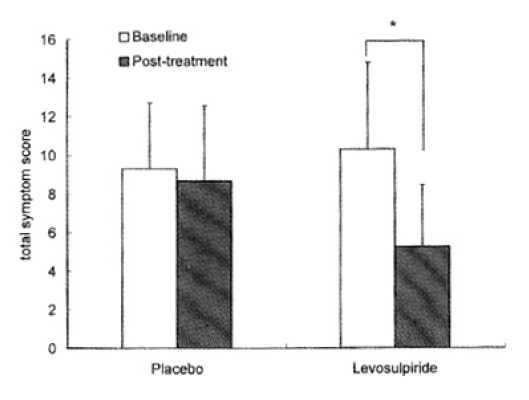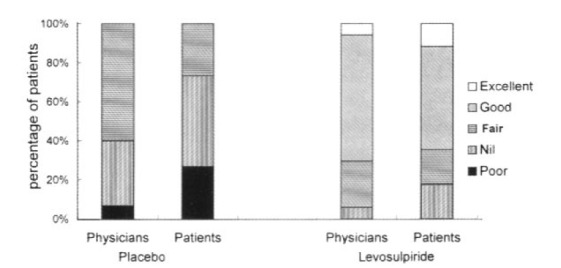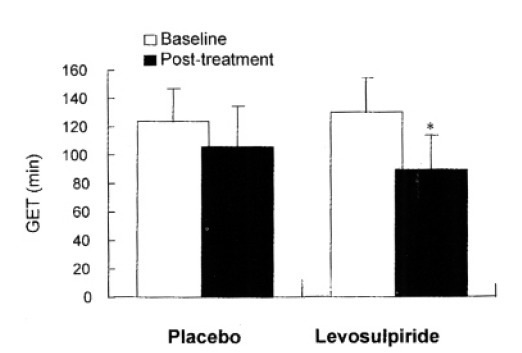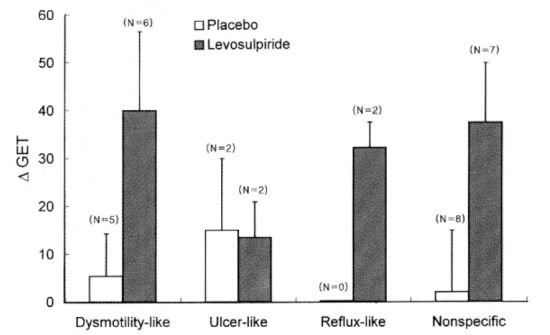Abstract
Objectives
Levosulpiride is the levo-enantiomer of sulpiride, a well-known antiemetic, antidyspeptic and antipsychotic drug. This study was undertaken to investigate the effects of levosulpiride on dyspeptic symptoms and gastric motor function in a group of patients with functional dyspepsia showing delayed gastric emptying.
Method
Forty two eligible patients were entered into a 3 week, double-blind randomized comparison of 25mg of levosulpiride or placebo t.i.d.. Symptom assessment and gastric scintigraphy following the intake of scrambled egg sandwich, were performed in each patient before and after treatment.
Results
The improvement of symptom score in levosulpiride group was higher than the placebo group (p<0.05). We assessed global efficacy, which was excellent in 1 (6%), good 11 (65%), fair 4 (24%), nil 1 (6%) of those receiving levosulpiride, and fair 9(60%), nil 5 (33%), poor 1 (6%) of those receiving placebo. Levosulpiride tended to be more effective than placebo in relieving the dyspeptic symptoms especially in the subgroups of dysmotility-like (p<0.05) and nonspecific (p<0.05) as compared to other subgroups (p=0.16). The reduction of gastric emptying time after levosulpiride treatment was more marked than Placebo group (p<0.05). We found a significant correlation between changes of symptom score and gastric emptying time (r=0.47, p=0.01. No serious adverse effects were reported after administration of either levosulpiride or placebo. Only two patients reported mild somnolence during levosulpiride administration.
Conclusions
Levosulpiride is effective and well tolerated in patients with functional dyspepsia accompanied by delayed gastric emptying. Its efficacy may be related to its action on the gastric motor function by improving the delayed gastric emptying.
Keywords: Levosulpiride, Functional dyspepsia, Gastric emptying
INTRODUCTION
Levosulpiride is the levo-enantiomer of sulpiride, a well-known antiemetic, antidyspeptic and antipsychotic drug1). It has shown greater central antidopaminergic activity, antiemetic and antidyspeptic effects and lower acute toxicity than both the racemic and dextro forms2–4). Due to its peripheral anti-dopaminegic action, levosulpiride has a therapeutic role also in gastro-enterology as a modulator of the motor activity of the upper digestive tract5–11). This double-blind, placebo-controlled study was undertaken to assess the efficacy of levosulpiride in patients with functional dyspepsia accompanied by delayed gastric emptying.
MATERIALS AND METHODS
1. Patients
Forty two patients with functional dyspepsia accompanied by delayed gastric emptying were enrolled into the study. The patients included 9 male and 33 female patients with a mean age of 40 yr.(range 18–64 yr.).
2. Inclusion criteria
Outpatients with chronic or recurrent dyspepsia of moderate to severe intensity were eligible for entry into the study. The symptoms of dyspepsia included eructation, heartburn, regurgitation, early satiety, postprandial bloating, anorexia, nausea, vomiting, epigastric pain or soreness for more than 1 month. The subjects must have at least one of the aforementioned symptoms with moderate to severe intensity and also must have delayed gastric emptying to be eligible. Delayed gastric emptying was defined as the gastric half emptying time (T1/2) being more than 100 minutes, according to gastric scintigraphic measurements. The cut off value was established on the basis of previous studies done in our laboratory and the normal range was 77.7±12.1 minutes. Upper gastrointestinal organic diseases were excluded by endoscopy, and patients showing typical symptoms of reflux disease such as heartburn and regurgitation without any other dyspeptic symptoms, or patients with reflux disease confirmed by 24 hour esophageal pH study were excluded. None of the patients had a history of gastric surgery or other physical conditions that could interfere with the performance or interpretation of the study. None of the female patients were pregnant or lactating and none had received drugs that could affect gastric motility during the week preceding the examination.
3. Allocation to treatment
Levosulpiride 25mg t.i.d. or placebo were administered to 42 patients having functional dyspepsia with delayed gastric emptying for 3 weeks, randomly. In each subject, the study medication was taken before the three main meals. Concomitant use of antacids, antispasmodics or other antidyspeptic drugs was prohibited during the study.
4. Study plan
A medical examination was performed on the patients selected for the study. Details of their dyspepsia histories, endoscopic findings, concomitant diseases, and current drug treatments were recorded. Dyspeptic symptom scores and the gastric half emptying time of a solid meal were measured at the beginning of the study and after 3-week treatment of levosulpiride or placebo. Depending on prevalent symptoms, patients with dyspepsia were allocated into dysmotility-like, ulcer-like, reflux-like or nonspecific dyspepsia groups.
5. Dyspeptic symptom scoring
Dyspeptic symptoms were scored by the physician, using a 4-point scale (0=absent; 1=mild; 2= moderate; 3=severe), on entry and on completion of 3 week treatment period. The physician and patient also made independent global assessment of therapeutic efficacy, indicated as excellent (complete relief of symptoms), good (improvement with only occasional symptoms), fair (slight improvement with some persistence of symptoms), nil(no improvement) and poor (deterioration of symptoms). Adverse events were also assessed.
6. Measurement of gastric emptying
A solid meal, scrambled egg sandwich, labeled with 1mCi of Tc-99m sulfur colloid was administered, together with a orange juice. This standard meal provided about 375Kcal. Thirty to sixty minutes before having their test meal and scintigraphy, a dose of levosulpiride/placebo were administered to the patients. The data collection was started immediately after the meal in supine position in a dual head gamma-camera. Both anterior and posterior images were taken simultaneously. The radioactivity of the gastric area was recorded for 1 minute at 15-minute intervals for two hours. Throughout the study the examinees were allowed to move, but smoking, eating and drinking were prohibited. The data were corrected for the radio-isotope decay. The geometric mean was calculated from the anterior and posterior data, then the gastric emptying curve was generated by least square fitting meth-od. The gastric half emptying time (T1/2) was defined as the time to be taken for one-half of the test meal to be emptied.
7. Statistical analysis
To compare baseline with 3-week results, paired t tests were conducted, and statistical significance was established at the p<0.05 level. Pearson correlation analysis was used for relationship between changes of symptom score and gastric emptying time.
RESULTS
Forty two patients entered the trial. Their sex and age distribution and pretreatment evaluation of total symptom scores and gastric emptying time are presented in Table 1. According to the dyspepsia classification, 14 (33%) of the 42 patients were diagnosed as having dysmotility-like dyspepsia, 4(10%) ulcer-like, 4(10%) reflux-like, and 20 (47%) nonspecific dyspepsia. 32 of 42 patients were eligible for efficacy analysis, 17 patients were received levosulpiride and 15 patients were received placebo.
Table 1.
Demographic and Pretreatment Evaluation of Patients Eligible for Entry into The Trial
| Features | Levosulpiride | Placebo | p-value |
|---|---|---|---|
| Age (yr) | 40.9±12.2 | 39.7±16.3 | NS |
| Sex (male:female) | 4:17 | 5:16 | NS |
| Height (cm) | 158.8±6.3 | 161.3± 7.4 | NS |
| Weight (kg) | 52.5± 8.6 | 55.5± 9.6 | NS |
| Total SS | 10.8± 4.5 | 9.3± 3.4 | NS |
| GET (minute) | 130.0±30.1 | 123.9 ± 23.1 | NS |
SS; symptom score, GET; gastric emptying time
1. Dyspeptic symptom scoring
The total symptom score of baseline and 3-week after treatment in levosulpiride group were 10.8±4.5 and 5.2±3.2 respectively, whereas 9.3±3.4 and 8.7±3.9 in the placebo group (Fig. 1).
Fig. 1.

Total symptom scores before and after 3 weeks of treatment with placebo or levosulpiride.
*: P<0.05
The improvement of total symptom score of levosulpiride group was higher than that of placebo group (p=0.001). The global efficacy was assessed by physicians as being excellent in 1 (6%), good 11 (65%), fair 4 (24%), nil 1 (6%) in the levosulpiride group and fair in 9 (60%), nil 5 (33%) and poor 1 (6%) in the placebo group. The patients’ assessments were similar, being excellent in 2(12%), good 9(53%), fair 3(18%), nil 3(18%) of those receiving levosulpiride, and fair 4 (27%), nil 7 (47%), poor 4 (27%) of those receiving placebo(Fig. 2). Levosulpiride showed a greater efficacy than placebo in relieving the dyspeptic symptoms in the groups of dysmotility-like (p=0.02) and nonspecific (p=0.01)(Fig. 3).
Fig. 2.

Global evaluation after 3 weeks of treatment with placebo or levosulpiride by physicians and patients.
Fig. 3.

Improvement of symptom scores before and after 3 weeks of treatment with placebo or levosulpiride for the subgroups of functional dyspepsia. No patients affected by reflux-like dyspepsia are in the placebo group.
*: P<0.05
2. Measurement of gastric emptying
The gastric emptying time of baseline and 3-week after treatment in levosulpiride group were 130.0±30.1 and 89.6±22.4 minutes respectively, whereas 123.9±23.1 and 106.1±23.6 minutes in the placebo group (Fig. 4). The reduction of gastric emptying time in the levosulpiride group was more marked than placebo group (p=0.01) (Fig. 5). There was a significant correlation between changes of symptom score and changes in gastric emptying time (r=0.47, p=0.01).
Fig. 4.

Gastric emptying times before and after 3 weeks of treatment with placebo or levosulpiride.
GET: gastric emptying time
*: P<0.05
Fig. 5.

Improvement of gastric emptying times before and after 3 weeks of treatment with placebo or levosulpiride for the subgroups of functional dyspepsia. No patients are affected by reflux-like dyspepsia in the placebo group.
GET: gastric emptying time
3. Adverse experiences
No serious adverse effects were reported after administration of either levosulpiride or placebo. Only two patients reported mild somnolence during levosulpiride administration.
DISCUSSION
Functional dyspepsia is very heterogeneous symptom complex including nausea, vomiting, early satiety, post-prandial fullness and epigastric pain without organic disease. The pathogenesis of dyspeptic symptoms is complex and still poorly understood and often related to motor abnormalities of the upper gastro-intestinal tract. Some cases of functional dyspepsia can be linked to gastric motility disturbances with the frequency being extremely variable (30–60%)12,13).
Recently, levosulpiride has been proposed in Europe for therapy of psychotic, depressive and somatoform disorders14) and has also shown that it is able to influence gastric motor activity7,8,15). The effect of levosulpiride on gastric motility is quite the reverse of most drugs used for the treatment of psychiatric disorders as most of these drugs tend to decrease gastrointestinal motility. Therefore, it is suggested that levosulpiride can control gastric motility disturbances as well as controlling dyspeptic symptoms from underlying depressive and somatoform disorders. Levosulpiride is the active form of sulpiride that blocks DA2 dopaminergic receptors at the central level and at the submucosal and myenteric plexus peripheral level16), which interacts with the cholinergic, adrenergic and peptidergic fibers to regulate the motility of gastrointestinal tract. Dopamine inhibits the cholinergic neurons of the upper gastrointestinal tract and levosulpiride acts as a prokinetic agent blocking the inhibition and hence permitting a sustained cholinergic induced contraction of smooth muscle cell in the myenteric plexus. Several studies have shown that levosulpiride can increase interdigestive migrating motor complex (IMMC) by means of manometry of gastric antrum17) and also reduce the gastric emptying time measured by scintigraphy15).
There are many studies about the effect of prokinetic agents in the treatment of dyspepsia18–20). The relief of dyspeptic symptoms by these agents is superior to placebo, however, the relief is not always accompanied by an acceleration of gastric emptying21). These results suggest that the subjective improvement of dyspeptic symptoms may be the effect of drugs on central nervous system. Furthermore, these discrepancies may be caused by an inappropriate scoring system or technique to evaluate functional dyspepsia.
There are a number of scoring systems for assessing functional dyspepsia. So, in order to assess and evaluate functional dyspepsia clearly, we used a modified scoring system. For the grading of each symptoms, a diary table was used. Once a day, the patient graded the intensity of the symptoms on a scale of 0–3. From this table, the average grade for each symptoms could then be calculated. Finally we used the total symptom score to compare the effect before and after treatment of levosulpiride or placebo.
In studying gastric motor function, there are a variety of methods available, which in turn yield different results. So far, to evaluate gastric motor function, gamma scintigraphy is the standard method because of its precision, simplicity, and reproducibility. To achieve the best results from gamma scintigraphy, solid bolus is used because it is a better indicator of gastric motor function. A convenient measurement is the T1/2, or the time it takes for one-half of the test meal to leave the stomach. Delayed gastric emptying is defined as gastric half emptying time (T1/2) of more than 100 minutes (>mean+2SD) according to gastric scintigraphic measurements. This cut off value was established on the basis of our laboratory normal range, which is 77.7±12.1 minutes.
The classification of functional dyspepsia has been proposed as dysmotility-like, reflux-like, ulcer-like and nonspecific groups21). Although the classification of functional dyspepsia patients into these groups was a purely arbitrary and did not reflect the pathophysiologic mechanisms of functional dyspepsia, our results showed that dysmotility-like and nonspecific groups had a more delayed gastric emptying than reflux-like and ulcer-like groups. And levosulpiride improved dyspeptic symptoms greatly in dysmotility-like and nonspecific dyspepsia group compared with placebo. However, we had some problems in sample size of reflux- and ulcer-like dyspepsia subgroup. The reasons why we had few patients in these subgroups were probably due to inclusion criteria of these subgroups. We excluded reflux-like dyspepsia if a patient had typical reflux symptoms such as heartburn and regurgitation without any other dyspeptic symptoms or gastroesophageal reflux disease confirmed by 24 hr esophageal pH study. In a total group of functional dyspepsia accompanied by delayed gastric emptying, there was a close relationship between changes of symptom score and observed gastric emptying time.
After this trial, it has become necessary to compare the effects of levosulpiride with other prokinetic agents. Levosulpiride, when compared with metoclopramide or domperidone, proved to be significantly more effective in controlling chemotherapy-induced nausea and vomiting and dyspeptic symptoms7,22). Also, it was well tolerated and no extrapyramidal signs were observed.
Experimental studies and clinical controlled trials with levosulpiride showed that it was extremely well tolerated both in short and long term studies9,11,23). No side-effects requiring intervention were recorded and laboratory tests, electrocardiogram and arterial pressure were not modified11). As with other central antidopaminergic drugs, levosulpiride can antagonize the inhibition of dopamine on the prolactin producing cells of the anterior pituitary, thus inducing a hypersecretioin of prolactin5). However, in humans, this effect is not dose-dependent, but rather seems to be reduced after chronic treatment24) and in most cases it does not induce clinical symptoms of hyperprolactinemia.
In conclusion, our results suggest, by means of gastric scintigraphy, that levosulpiride is able to stimulate gastric motor activity during the digestive phase. Thus levosulpiride appears to be an effective agent for the treatment of functional dyspepsia with delayed gastric emptying.
REFERENCES
- 1.Gerlach J. New antipsychotics: classification, efficacy and adverse effect. Schizophrenia Bulletin. 1991;17:289–309. doi: 10.1093/schbul/17.2.289. [DOI] [PubMed] [Google Scholar]
- 2.Montanaro N, Gandolfi O, Dall’ Olio R. Relative potency of sulpiride stereoisomers at the level of CNS. In: Spano PF, editor. Sulpiride and other benzamides. New York: Raven; 1979. pp. 109–118. [Google Scholar]
- 3.Reina G, Sacchi C, Aguggini G. Analysis of antiemetic effects of sulpiride isomers in dogs. In: Spano PF, editor. Sulpiride and other benzamides. New York: Raven; 1979. pp. 83–100. [Google Scholar]
- 4.Corsini GU, Del Zompo M, Melis GB, Mangoni A, Gessa GL. (−) -sulpiride as a specific antagonist of low-dose effects of apomorphine in man. In: Spano PF, editor. Sulpiride and other benzamides. New York: Raven; 1979. pp. 255–267. [Google Scholar]
- 5.Arienti V, Ferrentino M, Micaletti E, et al. Efficacy of L-sulpiride in the treatment of dyspepsia and on gall-bladder dyskinesia: Controlled trial versus domperidone. Minerva Dietol Gastroenterol. 1987;33:1–5. [PubMed] [Google Scholar]
- 6.Arienti V, Magri F, Boriani L, et al. Levosulpiride versus clebopride in gastric and gallbladder emptying in patients with functional dyspepsia: Ultrasonographic evaluation. Curr Ther Res. 1991;49:575–587. [Google Scholar]
- 7.Cosmacini G. Sulpiride stereo-isomers in the radiological examination of the gastrointestinal tract. A preliminary study. Acta Ther. 1981;7:1–18. [Google Scholar]
- 8.De Rossi S, Cosmacini G, Cosmacini P. (−) sulpiride in the radiologic examination of the gastrointestinal tract. Curr Ther Res. 1990;47:707–16. [Google Scholar]
- 9.Mazzarella B, Mastronardi P, Cafiero T, et al. Antiemetic effect of L-sulpiride in obstetric patients. Curr Ther Res. 1988;43:255–261. [Google Scholar]
- 10.Pustorino S, lanni G, Migliorato D, et al. Effects of Levo-sulpiride on the kinetics of gallbladder emptying and duodenal-gastric reflux in patients with diopathic alkaline gastritis. Curr Ther Res. 1989;46:1110–1118. [Google Scholar]
- 11.Zanoboni A, Forgione A, Zanussi C. Antiemetic efficacy and safety of L-sulpiride in patients with digestive and other disorders. Curr Ther Res. 1987;41:903–914. [Google Scholar]
- 12.Wegener M, Borsch G, Schaffstein J, et al. Frequency of idiopathic gastric stasis and intestinal transit disorders in essential dyspepsia. J Clin Gastroenterol. 1989;11:163–168. doi: 10.1097/00004836-198904000-00010. [DOI] [PubMed] [Google Scholar]
- 13.Jian R, Ducrot F, Ruskone A, et al. Symptomatic, radionuclide and therapeutic assessment of chronic idiopathic dyspepsia. A double-blind placebo-controlled evaluation of cisapride. Dig Dis Sci. 1989;34:657–664. doi: 10.1007/BF01540334. [DOI] [PubMed] [Google Scholar]
- 14.Stanley M, Rotrosen J. Advances on biochemical psychopharmacology. New York: Raven press; 1978. The benzamides, pharmacology, neurobiology and clinical aspects; p. 35. [PubMed] [Google Scholar]
- 15.Passaretti S, Tosi T, Tittobello A. Effect of Levosulpiride on gastric emptying in helathy volunteers. Clin Tri J. 1990;27:100–102. [Google Scholar]
- 16.Guslandi M. The clinical use of levosulpiride. Curr Ther Res. 1993;53:1–18. [Google Scholar]
- 17.Passaretti S, Mazzotti G, Franzoni M, et al. Motilita antroduodenale nella dispepsia non organica. Gli Specializzati Oggi Gastroenterologia. 1992;1(Suppl 2):15–19. [Google Scholar]
- 18.Nagler J, Miskovitz P. Clinical evaluation of domperidone in the treatment of chronic postprandial idiopathic upper gastrointestinal distress. Am J Gastroenterol. 1981;76:495–499. [PubMed] [Google Scholar]
- 19.Hui WN, Lam SK, Lok ASF, et al. Sulpiride improves functional dyspepsia: A double-blind controlled study. J Gastroenterol Hepatol. 1986;1:391–399. [Google Scholar]
- 20.Corinaldesi L, Stanghellini V, Raiti C, et al. Effect of chronic administration of cisapride on gastric emptying of a solid meal and on dyspeptic symptoms in patients with idiopathic gastroparesis. Gut. 1987;28:300–305. doi: 10.1136/gut.28.3.300. [DOI] [PMC free article] [PubMed] [Google Scholar]
- 21.Colin-Jones DG, Bloom B, Bodemar G, et al. Management of dyspepsia; report of a working party. Lancet. 1988;12:576–579. [PubMed] [Google Scholar]
- 22.Masci E, Sorghi M, Tosi T, et al. Levosulpiride and domperidone in treatment of reflux esophagitis: Results a double-blind study versus placebo. Curr Ther Res. 1992;51:814–818. [Google Scholar]
- 23.Zanoboni A, Forgione A, Oppizzi G, Zecca L. Effectiveness of L(-)sulpiride in chemotherapy induced emesis. Chemiotherapia. 1983;2:311–316. [Google Scholar]
- 24.McMurdo MET, Howie PW, Lewis M, et al. Prolactin response to low dose sulpiride. Br J Clin Pharmacol. 1987;24:133–136. doi: 10.1111/j.1365-2125.1987.tb03153.x. [DOI] [PMC free article] [PubMed] [Google Scholar]


